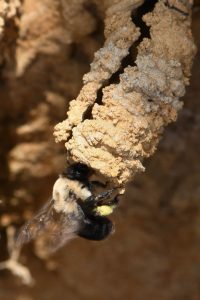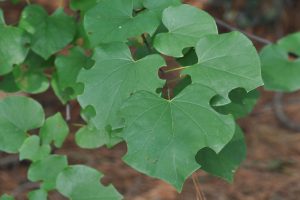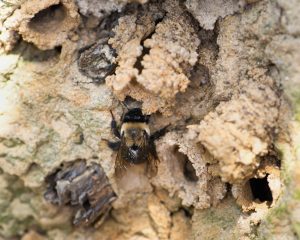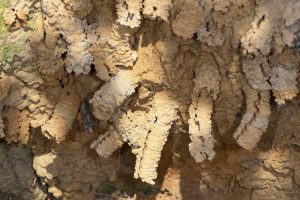National Pollinator Week
NATIONAL POLLINATOR WEEK 22-28 JUNE 2020
In recognition of National Pollinator I’d like to talk about two native bee species that are currently active here at NBG, but first I’d like to cover some general information on pollinators.
Pollinators include a wide variety of creatures such as bees, flies, butterflies, moths and even bats. Bees are by far the most important and efficient pollinators because of the fact that unlike most of the other creatures mentioned above, their contact with pollen is very deliberate and critical to their life cycle. While a butterfly may pick up some pollen while in the process of nectaring on a flower and possibly move it to another flower of the same species, bees (specifically female bees) actively collect pollen and use it to feed their young. Most bees will mix the pollen with nectar to form what is commonly called “bee bread,” which is eaten by their larvae.
Most Americans tend to associate the word “Pollinator” with the iconic honeybee, which is actually European in origin. Colonists didn’t bring honeybees across the ocean to provide pollination services – they were actually brought over primarily for their honey and bees wax, which colonists used for making candles.
We have around 4,000 species of bees native to the U.S. and around 400 native to the commonwealth of Virginia. Unlike honeybees, almost all of them are what are known as “solitary” bees since they do not nest in hives or colonies. Solitary bees are generally classified as stem-nesting (above ground) or ground-nesting, and females lay their eggs and provision them independently. This form of “social distancing” has helped them avoid some of the threats that face bees that live together in hives or colonies where mites, fungi and other pathogens can spread rapidly.
The first bee on my list today is the “leafcutter” bee, one of my absolute favorites! Leafcutter is a broad term — there are numerous species in the local area, most of them from the genus Megachile. I first learned about leafcutter bees when I noticed some very concise circular portions were being cut from leaf margins on a Redbud tree in my back yard almost ten years ago. The tree was very young at the time and I was concerned the apparent “damage” might hurt my tree — I was on the verge of reaching for an insecticide but luckily decided to do some internet research instead.
It didn’t take me long to discover that these were signs of leafcutter bee activity — activity that does NOT damage the tree. Leafcutter bees use their mandibles to cut leaf material that they use to line stems and cavities that they nest in. They also use it to build “walls” between cells where they lay an egg and provision it with bee bread for the larva to eat when it emerges. Leafcutter bees are among the easiest of native bees to identify due to the fact that they store their collected pollen on the bottom of their abdomens. They prefer open faced flowers and often point their little “bee butts” up in the air as they move across the bloom to avoid losing any of their hard-earned pollen. Some of their favorite flowers in our Pollinator Garden are the Stokes Aster, Mountain Mint, Rudbeckias and Sunflowers.
The second bee on my list is one that I’ve seen here at NBG for the first time in years – the Chimney Bee. Chimney bees are a type of ground nesting native bee, their scientific name is Anthophora abrupta. Most of the time I’ve noticed them here they are nesting in a root ball from a tree that has fallen during a storm. The origin for their name is very obvious – they build mud “chimneys” that protrude from the soil, sometimes several inches long. The purpose of these chimneys is not known for certain. Some scientists speculate they protect the bees from rain and wind while they’re actively nesting, while others believe they might be “thermal regulators” where the bees can warm up faster before they head out to nectar and collect pollen in the morning. Chimney bees are sometimes described as gregarious. While the females excavate and provision their burrows by themselves, they seem to enjoy the company of other chimney bees while they do it! This leads to an intense level of activity during peak nesting periods, with bees quickly darting in and out of their burrows. This activity may seem alarming but chimney bees have a reputation (like virtually every other solitary bee!) for being very non-aggressive. Another thing they have in common with other solitary bees is that in the highly unlikely event they do sting, the sting is very mild. Many solitary bees cannot sting at all! I point this out because I have talked to countless people who assume every flying insect that emerges from a hole in a ground is a yellow jacket and immediately break out a can of wasp spray. Please remember that about 70% (about 280 species) of native bees in Virginia are ground nesting – always make sure you’ve properly identified an insect before taking any action!

A female chimney bee (Anthophora abrupta) climbs into her “chimney” on an overturned tree in the Virginia Native Plant Garden early June of this year.
I know some people may think that putting a native bee nesting block or stem bundle is a great way to support our native bees, but there are a lot of products being sold these days that probably do more harm than good. Encouraging some of our solitary bees to nest so close together disrupts their social distancing and can lead to the spread of pathogens and increased predation by everything from woodpeckers to parasitizing wasps. If you decide to put a nest box out, buy it from a reputable source and understand that there is some maintenance and cleaning involved.
If you want protect the future of native pollinators like my leafcutter and chimney bee friends, here are three simple tips:
- Eliminate broad-spectrum insecticides in your yard and reduce all pesticide use. Always identify a pest before treating and use the most targeted and eco-friendly product possible.
- Plant as many regional natives as possible. Native insects and plants evolved together and have developed mutually beneficial relationships.
- Leave some areas of your yard undisturbed to the greatest extent possible. There are literally hundreds of beneficial insects that spend part of their life cycle (usually as pupae or larvae) in leaf litter and other organic debris. It would be a shame to rake them up and put them in a bag.
I hope you take the time to visit us during National Pollinator Week – if you see me working in the Wildflower Meadow or Pollinator Garden I’d be more than happy to show you some of our other awesome native pollinators!











